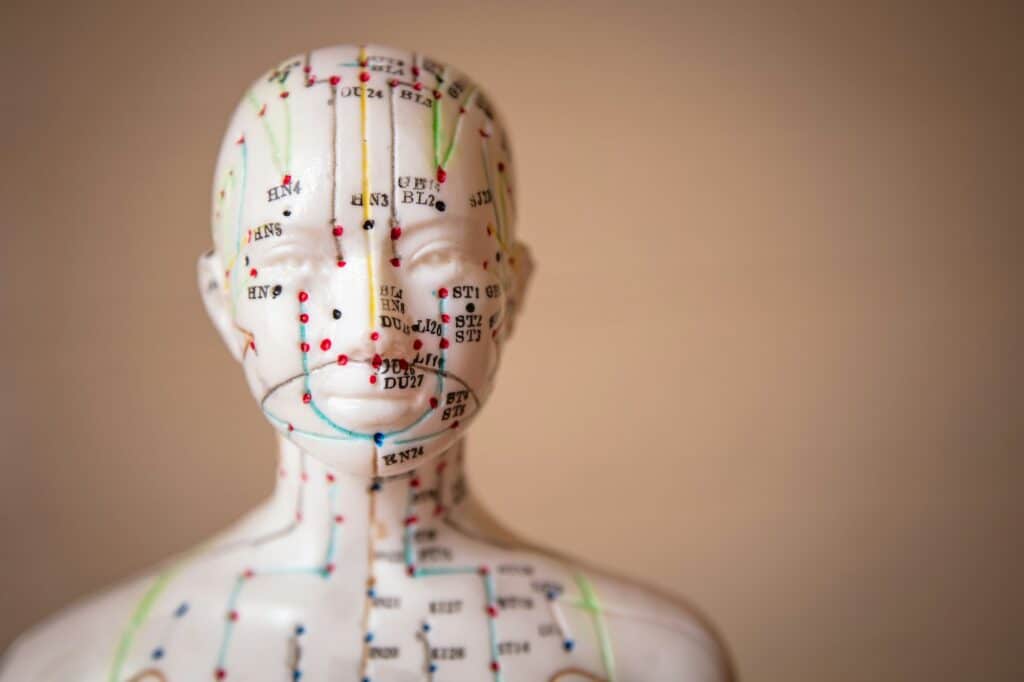Acupuncture, an ancient practice rooted in Traditional Chinese Medicine, continues to captivate modern interest for its holistic approach to healing. Central to its effectiveness are acupuncture points, intricate nodes along the body’s meridian pathways. Understanding these acupuncture points is paramount for practitioners and enthusiasts alike, as they serve as gateways to balancing energy flow and addressing various ailments. In this comprehensive guide, we delve into the intricacies of acupuncture points, unlocking their therapeutic potential and shedding light on their profound role in wellness.
The Origins of Acupuncture: Exploring Ancient Wisdom
Acupuncture finds its roots in the rich tapestry of ancient Chinese civilization, dating back thousands of years. Legend has it that this therapeutic practice originated when healers observed that stimulating specific points on the body could alleviate pain and restore health. Over centuries, this empirical knowledge evolved into a sophisticated system of healing known as Traditional Chinese Medicine (TCM).
Acupuncture, a cornerstone of TCM, embodies the holistic approach to wellness that characterizes this ancient medical tradition. By exploring the origins of acupuncture, we gain insight into the profound connection between human health and the natural world, as well as the enduring wisdom passed down through generations.
The Fundamentals of Traditional Chinese Medicine (TCM)
Traditional Chinese Medicine (TCM) is a holistic approach to understanding the human body as an interconnected system influenced by nature. It views health as a balance between yin and yang forces and the flow of vital energy, known as qi. TCM’s concept of meridians connects internal organs with external environments.
Acupuncture, along with herbal medicine and dietary therapy, aims to restore this balance and promote the body’s innate healing ability. Understanding TCM principles provides a comprehensive understanding of acupuncture’s effectiveness in maintaining health and well-being.
Unveiling the Mysteries of Acupuncture Points
Acupuncture points, or acupoints, are vital junctures along the body’s meridian pathways where vital energy, or qi, can be accessed and manipulated. These points, numbering hundreds, have therapeutic significance and are mapped out across the body.
Despite their existence for centuries, their exact nature and mechanisms remain elusive. Exploring their anatomical, physiological, and energetic properties and therapeutic applications provides deeper insight into the intricate connections that underlie health and healing, bridging ancient wisdom with contemporary science.
Mapping the Body’s Meridian Pathways
Traditional Chinese Medicine (TCM) focuses on the body’s meridian pathways as vital energy pathways, linking organs, tissues, and systems for balance. By mapping these pathways, practitioners can identify areas of imbalance or dysfunction, and acupuncture points are strategically located along these meridians to restore qi flow and promote health. This understanding of the body’s meridian system provides a foundation for acupuncture practice and enhances appreciation for its holistic approach to healing.
The Significance of Acupuncture Points in Healing
Acupuncture points are vital in the healing process, serving as gateways to the body’s innate healing potential. They correspond to specific organs, tissues, and physiological functions, and stimulating them can restore balance and promote wellness. Acupuncture points provide valuable diagnostic information, allowing practitioners to identify patterns of disharmony within the body and tailor treatment accordingly.
They are dynamic centers of energy that respond to internal and external influences, reflecting the ever-changing nature of health and disease. Recognizing the significance of acupuncture points highlights the interconnectedness of mind, body, and spirit, underscoring the holistic approach of acupuncture as a healing art.
Understanding Acupuncture Point Functions
Acupuncture points have distinct properties and functions, influencing their therapeutic effects. Some regulate qi flow, while others target specific organs or systems. Understanding these points involves examining their location, energetic characteristics, and clinical indications. Some points alleviate pain, while others promote digestion or relaxation.
They can be classified as tonifying, dispersing, or harmonizing, offering a variety of therapeutic options. By comprehending these functions, practitioners can improve treatment effectiveness and address various health issues with precision and efficacy.
Exploring the Diversity of Acupuncture Point Locations
Acupuncture points are scattered throughout the body, indicating the interconnectedness of the body’s systems and functions. Some points are along major meridians, corresponding to specific organs or structures, while others are in subtle or unexpected areas.
This diversity allows for targeted treatment of various health conditions, including musculoskeletal pain and internal imbalances. The location of these points also holds symbolic significance in Traditional Chinese Medicine, reflecting the body’s connection to the natural world. Exploring these points offers insight into the body’s wisdom and resilience.
The Role of Acupuncture Points in Balancing Energy Flow
Acupuncture is a practice that focuses on balancing the flow of energy, or qi, through the body’s meridian pathways. Acupuncture points are used to manipulate qi and restore harmony within the body. Stimulating specific points can regulate qi flow, promoting smooth circulation and optimal functioning of the body’s systems.
This practice extends beyond the physical realm to emotional, mental, and spiritual well-being. As qi flows freely, it nourishes all aspects of our being, fostering vitality, clarity, and balance. Understanding acupuncture points’ role in balancing energy flow provides a holistic approach to promoting health and wellness.
Unlocking the Healing Potential: How Acupuncture Points Work
Acupuncture points are vital for accessing the body’s innate healing potential and promoting self-regulation. When stimulated with needles or pressure, these points trigger physiological responses that promote relaxation, pain relief, and overall well-being.
Research suggests that acupuncture may release endorphins, neurotransmitters, and other biochemicals that modulate pain perception, reduce inflammation, and promote tissue repair. Acupuncture points also influence the flow of vital energy through the body’s meridian pathways, restoring balance and harmony.
Techniques for Locating and Stimulating Acupuncture Points
Acupuncture is a healing practice that involves precise techniques to locate and stimulate acupuncture points to induce therapeutic effects. Acupuncturists use methods like palpation, visual inspection, and anatomical landmarks to identify these points. The stimulation can be done using needles, pressure, heat, or electrical stimulation, depending on the desired outcome.
Techniques vary based on the individual’s constitution, health condition, and practitioner’s experience. Mastering these techniques can improve treatment effectiveness and facilitate profound healing and transformation.
Exploring Acupuncture Point Associations with Specific Organs and Conditions
Traditional Chinese Medicine (TCM) focuses on the association of acupuncture points with organs, tissues, and physiological functions in the body. By stimulating these points, practitioners can address various health conditions and promote balance. For instance, points on the Liver meridian can regulate menstrual cycles and alleviate emotional imbalances, while points on the Lung meridian can relieve respiratory symptoms and strengthen the immune system. Understanding these associations allows practitioners to tailor treatments to individual needs and promote targeted healing.
The Science Behind Acupuncture: Evidence-Based Insights
Acupuncture, a traditional Chinese medicine, has been studied for its therapeutic benefits and physiological effects. It has been found to modulate pain perception, regulate inflammatory responses, and promote the release of neurotransmitters. It also influences autonomic nervous system function, hormonal balance, and immune responses.
Advances in neuroimaging techniques have shown changes in brain activity and connectivity associated with acupuncture. This research bridges the gap between ancient wisdom and modern science, validating its efficacy and opening new avenues for exploring its potential applications in healthcare.
The Integration of Acupuncture Points in Modern Healthcare
Acupuncture is increasingly being used as an adjunctive therapy in modern healthcare, complementing conventional treatments and enhancing patient care. It is now offered in various health conditions, including chronic pain, musculoskeletal disorders, anxiety, depression, and infertility.
This integration reflects the growing appreciation for Traditional Chinese Medicine’s holistic approach and the demand for safe, effective, and patient-centered therapies. By incorporating acupuncture into comprehensive treatment plans, healthcare providers can address patients’ complex needs and promote optimal health throughout their lifespan.
Exploring Acupuncture Points in Pain Management and Rehabilitation
Acupuncture points are known for their analgesic properties and ability to relieve pain and discomfort in various body parts. They are effective in reducing pain intensity, improving mobility, and enhancing quality of life. Acupuncture can also aid in rehabilitation after surgery, promoting faster recovery, reducing inflammation, and promoting tissue healing.
By targeting specific points associated with pain perception and musculoskeletal function, practitioners can tailor treatments to address pain’s underlying causes and restore balance. This research offers new perspectives on pain treatment and promotes healing and recovery.
Incorporating Acupuncture Points into Daily Self-Care
Acupuncture is a versatile tool that not only treats specific health conditions but also enhances overall wellness and prevents illness. By incorporating acupressure techniques into daily self-care routines, individuals can promote qi flow, alleviate stress, and support the body’s natural healing processes.
Acupuncture points like LI4 (Hegu) and LV3 (Taichong) are effective for relaxation, headache relief, and immune function. By understanding these points and their therapeutic effects, individuals can actively maintain their health and connect with their bodies and the natural world.
Alternative Approaches to Stimulating Acupuncture Points
Acupuncture, a traditional Chinese medicine, uses fine needles to stimulate acupuncture points, but there are alternative methods like acupressure, moxibustion, cupping, and laser acupuncture. These techniques are accessible to those sensitive to needles or prefer non-invasive methods.
By exploring these methods, individuals can find the one that resonates with their preferences and needs, enhancing the effectiveness and versatility of acupuncture as a holistic healing modality. The goal remains the same: to activate the body’s innate healing potential and restore balance and harmony within the body, mind, and spirit.
This guide has offered a comprehensive overview of the intricate world of acupuncture points, shedding light on their profound role in promoting health and wellness. Whether you’re seeking relief from pain, managing chronic conditions, or simply aiming to optimize your overall well-being, understanding acupuncture points is essential.
At ActiveMed Integrative Health Center in Encinitas, we’re committed to helping you achieve your health and wellness goals through our natural medical services. Contact us today at 858-673-4400 or email us at info@activemedhealth.com to schedule an appointment and discover how acupuncture points, along with our holistic approach, can transform your health journey.





